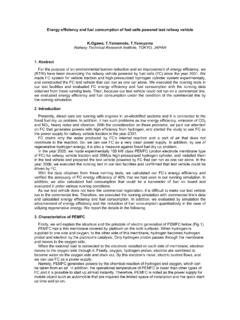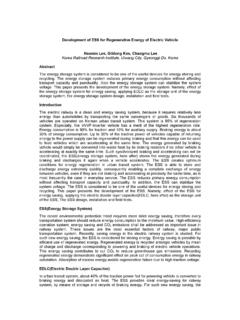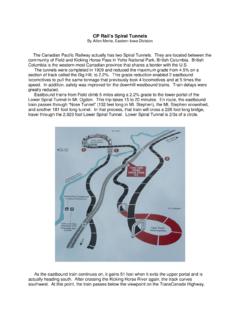Transcription of Fire Detection in Metro and Railway Tunnels
1 Challenge H:For an even safer and more secure railwayFire Detection in Metro and Railway TunnelsWalter Costa Teixeira Pinto,F bio Mori, Cia do Metropolitano de S o Paulo, S o Paulo, BrazilJorge Rady de Almeida Junior, Escola Polit cnica da Universidade de S o Paulo, S o Paulo, BrazilKeywords:fire, detectors, tunnels1. INTRODUCTIONThe growing concern about safety in underground transportation systems, exacerbated byrecent occurrences of accidents inmetrotunnels at a worldwide level, represents a great safetychallenge to most of the Metro and Railway systems. Among those accidents, there is the occurrenceof fire in Metro and Railway Tunnels . It is thus a great challenge tobe protectedagainst fire in suchconditions, and it is very important to have means to detect any signal of fire as early as order to provide safety for the Railway transport,different types ofequipmentare usedthatallow bettersupervision andcontrol of the various events that mayoccurduring its ,whichinmetro andrailway Tunnels may be considered a complexand a challenging issue,as discussed in(MICLEA, 2009):1.
2 The variation in air speed coming from the main ventilation system and the piston effect of thetrains may maskoccasionalfocus of fires by decreasing the temperature, and by interfering withoptical It is difficult to transmit the signals to the fire central Detection because of the long , the aim is to present a study on several kinds of fire Detection equipment,andemploythem in Metro and Railway smoke, optical, photoelectric,ionization, flame, ultraviolet and infrared detectors,surveyingtheir main positive and of the importanttechnical aspectsoffire detectorsis theirability to transmit signals overlong distances, enablingthe communication of these detectors withthesupervisory system located inthe nearest station.
3 Moreover, it is necessary to examine the equipment efficiency,in a hostileenvironment,such asa Metro or metros and railwaysthat have Tunnels are potential candidates to receive a system as theone , the impact on Metro and Railway business is very great, because a safertransportation system always means a system that has a greater potential to be more ofthe existent solutionsfor fire Detection in Metro and Railway tunnelsis inventory ofthe availableequipment that can be applied insuchsituationis made,pointingthetechnical characteristics of eachdetectortypeandits from those data, theproposalis to use a combination of two or three fire detectorstypes,seeking to obtain an adequate fire protection system, consideringtheirmain of the WorkSection2makesan explanation of fire in definition of fireis presented,as wellashow it is formedandwhichare risks involved in the event of a fire, especiallyifithappens in arailwaytunnel, are shown.
4 Insection3,the existingstandardsrelatedto firedetectionare shows the state of the artof theequipment available for fire varioustypes of detectorsare described,along withtheiroperation, theirmainfeatures,the advantages anddisadvantages of each and an analysisis madeof the devicesconsidered, seeking theirapplicationinmetro andrailway , section 5 presents the H:For an even safer and more secure DefinitionFire can bedefined asheat and flamethat arise in function of achemical transformation ofcombustible materials reactingwiththeoxygen contained intheair [ARAG O].The threeessentialcomponentsindispensableto the emergence and maintenance of fire arefuel, oxygen and heat.
5 When a chemical chain reaction (transfer of thermal energy in combustion)occurs,flamesspread,causing ,a fireis defined as a strongand uncontrollableexothermiccombustion reaction(oxidation-reduction). Usually in a fire, there issmokeemission, flames and combustion the oxidation is too slow,there are notflames,asin the case of iron oxidation or istoo fast, itis called deflagration. When it occurs almost instantly, itiscalled explosion or LoadsVarious materials that are found inrailwaytunnelsmay behaveas fuel in case of fire, as forexample:garbage, such as paper, probablythrown bytrainusers;wires and cables, components ofthe medium voltage systems; tunnel lighting;telecommunication equipment and others; the trainsthemselves and yet other rolling stock , intheequipment design,it is important tospecifynon-combustible materials, flame-retardantandthat do not emitsmokeortoxic fire load of each passenger carisestimated to befrom15 to 20 MW.
6 Thus,in theplanning and designingof railwaytunnels,anaverage power generation of30 MWis consideredincase of fire inside the evolution of the fireundergoesseveral phases(FIGUEIREDO, 2010): Thelatencyphasethathasan activation energy in quantity and qualityenoughtocreateathermal favorable condition,withenoughfuel and oxygen in sufficient concentration; Thestart-up phase,thedurationof whichdepends on the flammability, on thepossibility of flamespread,onthe decompositionrateof the materials involved in the fire,on thegeometry andvolume of sites,on theability to dissipate heat,on theventilation,on thesurface materialstype(structure, porosity) andonthe existence of contactpointsbetween the materials; Theacceleration phase,at whichtoxic and corrosive gasesare emitted;the burning rate, thetemperature and the radiation emittedincrease.
7 Thecombustion phaseat which the temperatureand the combustion speedrise exponentially,theamountofgases increases,andsome materials reach the point of self-ignition, producinggases and vapors; Thedeclinestageorextinction,atwhich the whole place is on fire and if there is no feedbackfrom the outside, the fire of a fire are: Thermal effect(the flames can reach temperatures of 2,500degreesCelsius); Optical effect, visible lightwithultraviolet and infrared radiationis emitted; Smoke, consisting of gases made opaque by solid particles of burning material; Miscellaneous,noises, ionized particles that derivefromvariouscombustion detectorchosenshould bethe one that canprovidethequickestandmost reliableresponses, taking into accountthe firetypemost likely to H:For an even safer and more secure in MetrosAlthoughunusual, fires inmetro andrailway have killed several people since 1903, whenabout 90 passengers diedintoxicatedby smoke intheCouronnesmetrostation,intheParisMet ro.
8 Inthis case, there was a fire in a locomotive at the station,butusersdidnotleavethe station waiting fora ticket of the most famouscasesisthe one thathappened in 1987 at Kings Cross Station peopledieddue to a fire inside the station, more precisely in a wooden escalator(FIRETATICS, 2005).One of the worst tragedies happened just inside ametrotunnel in Baku, Azerbaijan (formerSoviet Union): 285 people were killed and 256 others injured as a result of a fire on October 28, fire reached the crowded cars when the train was betweentwostations, which aggravated theoutputofthe train. Most deaths were caused by carbon tunnel wasknownto beequipped with greatcapacityfans, but it is unclear whether they were used at the time of thefire.
9 Afaultin the powernetworkand an abundance of combustible material in the carsarethemostlikely causesof this notorious casewas the attack occurred in Daegu, South Korea,on February 18,2003(BBC NEWS, 2003). A mentally disturbed man fired a gallon of gasoline in astationarytrain at ametrostation ofseveral operational failures,the passengers were prevented fromleaving the train, causing Paulo Metro ,there arealsocases of fire reported, and the most recent was inSeptember 2009 in a train located in theS Station, causing only some operational , in August 2001 a death occurred due tothe fireoriginated in electrical cables locatedneartheMarechalDeodoroStation.
10 The victim died of cardiac arrest, and thereweremore than 20intoxicated STANDARDSTheNFPA (National Fire Protection Association) and ABNT (Brazilian Association forTechnical Standards)standards are analyzed NFPA is an international regulatory authority in its area of operation, which alreadycovers the people transportation in underground railways in metropolitan areas(NFPA, 1999). TheABNT is a Brazilian Association that develops awidevariety of standards. Onecommittee of ABNT isthe EC-24: that discusses fire protection in Tunnels (ABNT, 2011).In general, the standards which focus on safety in Tunnels began to be adjusted in severalcountries after a remarkablefireoccurrence, with several deaths in the Mont Blanc tunnel in following year, in November 2000,there was another fire in a tunnel inanAustria cable car, whichkilled 155 NFPA standard that specifies themetrotunnels is the NFPA 130(NFPA130, 1999).

















